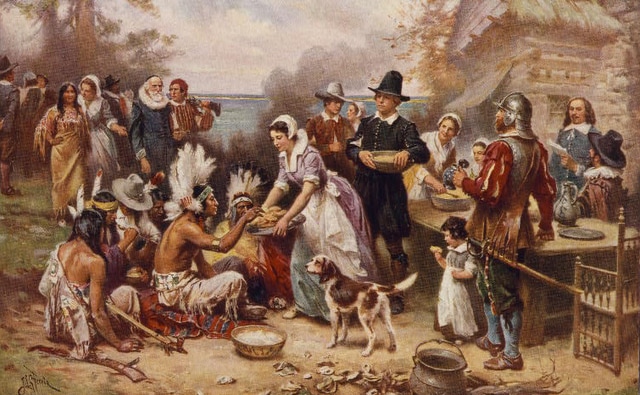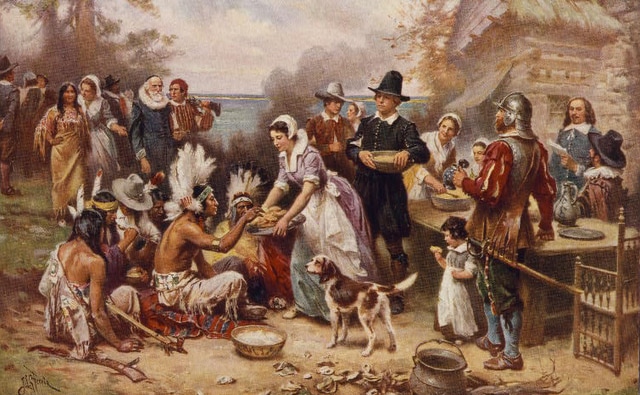

DARKE COUNTY — Popular tradition holds that the first Thanksgiving celebration in America was conducted in 1621 by the Pilgrims of the Plymouth Plantation in the Massachusetts Colony.
With their friendly Indian neighbors in attendance, the story goes, the Pilgrims consumed massive quantities of traditional Thanksgiving foods, all the while giving thanks to God for their survival during the colony’s first year of existence.
While the essence of the story is certainly true, it’s not exactly how things happened. There is much more to it than that, and believe it or not, theirs may not be the only Thanksgiving story.
Some historians contend that the New World had seen earlier Thanksgiving observances, with French and Spanish explorers preparing special meals and conducting services of thanks as early as the 1560s — at least five full decades before the Pilgrims’ arrival in Massachusetts.
Then there is the belief that Thanksgiving observances were held by the English settlers of the Jamestown Colony in Virginia as early as 1610.
And that’s not all. On Dec. 4, 1619 — two years before the Pilgrim Thanksgiving — English settlers of the Berkeley Hundred Plantation in Virginia commemorated their safe arrival in the New World with a day of Thanksgiving.
No matter the veracity of where and when the first Thanksgiving Day was celebrated in North America, the 1621 Pilgrim feast has established a tight grip on the holiday’s origins in the public mind.
But surely the Pilgrims eating traditional Thanksgiving fare is true, right? Not exactly.
The earliest primary document describing their Thanksgiving meal comes from a letter written by settler Edward Winslow, who wrote: “And God be praised we had a good increase… Our harvest being gotten in, our governor sent four men on fowling, that so we might after a special manner rejoice together after we had gathered the fruit of our labors. They four in one day killed as much fowl as, with a little help beside, served the company almost a week. At which time, amongst other recreations, we exercised our arms, many of the Indians coming amongst us, and among the rest their greatest king Massasoit, with some ninety men, whom for three days we entertained and feasted, and they went out and killed five deer, which they brought to the plantation and bestowed on our governor, and upon the captain and others. And although it be not always so plentiful as it was at this time with us, yet by the goodness of God, we are so far from want that we often wish you partakers of our plenty.”
While it is certainly conceivable that the “fowl” included wild turkey, it is equally possible the Pilgrims and their Indian guests dined on duck, geese or even swan.
According to the Plimoth Plantation Museum (www.plimoth.org), the Pilgrims in all likelihood ate fish, nuts, berries, and of course, corn, in addition to fowl and venison at their Thanksgiving meal — not necessarily what many Americans will see on their dinner tables Thursday.
As for mashed potatoes, the potato — white or sweet — was virtually unknown among the English at this point in history.
Cranberries may have been consumed, but not as the sweet, jellied confection we know today. The same holds true for pumpkin pie, as the colonists had no sugar to make the pumpkin sweet or butter and flour with which to make delicious flaky pie crust.
Though the turkey has become a symbol of the holiday, Americans’ Thanksgiving meal choices today vary from region to region. As long as everyone pushes themselves away from the table with their bellies satisfied, is there really a wrong food selection?
As for the date of the Pilgrim Thanksgiving, no one is completely sure on which days the Pilgrims’ celebration actually fell. As it is recorded as a three-day event occurring after the settlers’ harvest, it likely happened sometime in a range spanning from September to November.
Thanksgiving as a holiday has been observed sporadically since that time, typically on a regional, colony-by-colony or state-by-state basis. Some national Thanksgiving day observances were proclaimed during and in the years following the American Revolution.
Thanksgiving Day as a federally recognized holiday wasn’t established until 1863, when President Abraham Lincoln, in the middle of the Civil War, issued a proclamation saying, in part, “I do therefore invite my fellow citizens in every part of the United States, and also those who are at sea and those who are sojourning in foreign lands, to set apart and observe the last Thursday of November next, as a day of Thanksgiving and Praise to our beneficent Father who dwelleth in the Heavens.”
A permanent, fixed date for Thanksgiving, however, was not set until 1941, when the U.S. Congress passed a joint resolution establishing the holiday as the fourth Thursday of November.





